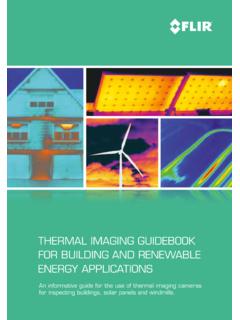Transcription of Large Linear Copper Thermal Evaporation Source for CIGS ...
1 Large Linear Copper Thermal Evaporation Source for CIGS solar Cell Applications 1 Large Linear Copper Thermal Evaporation Source for CIGS solar Cell Applications Keqi Zhang and Ralph Faber Vacuum Process Technology, LLC 70 Industrial Park Road, Plymouth, MA 02360, USA Abstract: A Large scale Linear Thermal Evaporation Source designed for evaporating Copper and other metals for CIGS photovoltaic solar cells is presented. Of the four elements (Cu, In, Ga, and Se) in the CIGS composition, Copper is the one with the highest melting temperature and thus most difficult to process. The focus of this paper will be mainly on Copper Evaporation and its results. The vapor Source described is a top down Linear Thermal Evaporation Source which is capable of depositing uniform Copper films on a Large substrate. Defect free Cu films with 5% thickness uniformity across a 120cm area have been demonstrated.
2 Deposition rates of up to 4g/min have been achieved. Theoretical simulation has indicated that the Cu film uniformity can be further improved to Key words: Thin films, CIGS, solar cells, Copper , Thermal Evaporation 1 Introduction Two types of technologies are currently used in the solar industry to develop and manufacture photovoltaic solar cells: 1) crystalline (or polycrystalline) wafer based and 2) thin film based. Due to the increasing demand for clean, renewable energies, both wafer and thin film based photovoltaic technologies have advanced considerably in recent years. However, with some clear advantages of thin films [1], such as low material usage, Large monolithic construction, and low cost manufacturing, thin film based solar cells are increasingly gaining market shares [2]. Currently the leading commercial thin film technologies are CdTe, CIGS and polycrystalline silicon.
3 Due to environmental, efficiency and cost considerations, CIGS appears to be the most promising one with the highest potential. CIGS thin films are mainly deposited by two different PVD technologies: sputtering and Thermal Evaporation . However, the efficiencies of CIGS solar cells fabricated with Thermal Evaporation are consistently higher compared to sputtering. This is because co-evaporating Cu, In, Ga, and Se leads to larger crystal growth in the CIGS absorber layer that results in improved electrical transport properties of the solar cells. Also, the highest known efficiency of CIGS solar cells ( ) is produced by a co- Evaporation process on a cell [3]. The major objective for the solar industry is to overcome the scaling challenges of the production equipment, including the Thermal Evaporation technology, so that high efficiency CIGS solar cells can be realized at low cost.
4 Large Linear Copper Thermal Evaporation Source for CIGS solar Cell Applications 2 The Linear Vapor Source developed by Vacuum Process Technology is specifically designed to address this scaling issue. It provides an effective tool for the solar industry to precisely deposit the required metals for the CIGS absorber layers, with a very stable Evaporation rate and excellent uniformity. 2 Design of the VPT Linear Vapor Source The VPT Linear Vapor Source is a top down Thermal Evaporation Source that can be used in in-line coating systems to thermally evaporate metals or other semiconductor materials for thin film solar photovoltaic applications. It has the capability to deposit a 140cm wide substrate uniformly with a dynamic deposition rate (for Cu films) of up to 300nm m/min or static Evaporation rate of grams/min. Figure 1 shows a schematic with the basic design concept of the Linear Vapor Source .
5 As can be seen, an Evaporation material, such as Cu, is being heated in a crucible 201 to a temperature range between 1250 C and 1400 C. The evaporated Cu creates a high vapor pressure differential between the pressure compartment 205 and the substrate area. The pressure at the substrate area is typically one to two orders of magnitude lower, therefore the Cu vapor is directed through the vapor shaping channel 210 and deposited from top down on to the moving substrate 213. The Linear Vapor Source is designed to continuously operate in vacuum systems in a production environment to deposit high purity thin films. It is critical that proper materials are selected for the Vapor Source , to ensure that 1) the Source materials are compatible with the evaporated materials (Cu, In, Ga and Se); and 2) there is no cross contamination between the Source and the evaporated materials.
6 Figure 1: Schematic of the VPT Linear Vapor Source Producing high efficiency CIGS solar cells is a complex process; many factors have to be taken into account which will affect the performance and efficiencies. One of the key issues in the fabrication process is to obtain a high quality CIGS absorber layer that has an optimal and homogeneous composition Large Linear Copper Thermal Evaporation Source for CIGS solar Cell Applications 3 on a Large scale substrate with high repeatability. Copper is one of the key elements in the CIGS absorber layer and it is critical that it can be deposited with a predictable and stable Evaporation rate while maintaining excellent film uniformity on Large scale substrates. It has been simulated that the Cu Evaporation rate in vacuum is a function of its melted surface area and temperature.
7 Figure 2 shows such a relation. It is obvious that with a higher temperature and a larger melted surface area, the Evaporation rate increases. Figure 2: Relation of Cu s Evaporation rate versus the temperature and melted surface area. With the Vapor Source operating at around 1300 C, the Source temperature needs to be accurately controlled within 1 C in order to maintain a desired deposition rate stability of The film thickness uniformity is always an important parameter to consider for Large scale substrates. The substrate size used for CIGS can be over one meter wide and special attention needs to be paid to the Cu film uniformity. It is well known that in the vacuum deposition process, thin film uniformity is primarily dependent on the relative location of substrate and Evaporation Source , the material properties, the deposition method and conditions, and the geometry of the vapor shaping channel.
8 By considering all the factors above, a simulation model was created and the film thickness distribution along the shaping channel can be predicted. Figure 3 shows the simulated Cu film thickness uniformity. As it can be seen, it is possible to control the Cu film thickness uniformity within in the central 1200mm region along the Source shaping channel. The uniformity falls off rapidly at both ends of the shaping channel which is the result of the edge effect of the Evaporation Source . Based on the discussion above, a top down Linear Vapor Source which is capable of thermally evaporating Cu and other metals for CIGS photovoltaic solar cells has been developed. The expected performance of the vapor Source is summarized in Table 1, and an overview of the vapor Source is shown in Figure 4. Large Linear Copper Thermal Evaporation Source for CIGS solar Cell Applications 4 Figure 3: Simulated uniformity of the Vapor Source with a 1600mm long vapor shaping channel.
9 Table 1. VPT Vapor Source performance(for Cu Evaporation ) Description Value Source dimension L(mm) W(mm) H(mm) 2100 400 400 or L(mm) W(mm) H(mm) 1500 400 400 Deposition method In-line Thermal Evaporation Deposition type Top - down Source exit slit to substrate distance(adjustable, mm) 300 -500 Substrate width (mm) up to 1200 Source uniformity ( Source center to 600mm) < 5% Static Evaporation rate (maximum) g/min 1 - 6 nm/s 2 - 15 Dynamic deposition rate (nm m/min) 50 - 300 Evaporation rate stability 2% Source operating temperature - nominal ( C) 1300 Source operating temperature - minimum ( C) 1200 Source operating temperature - maximum ( C) 1350 Source temperature stability, crucible ( C) 1 Substrate temperature ( C, typical) 550 Source crucible capacity (cm ) 2400/4800 Source power consumption (kW) 60 - 80 Process pressure (torr, typical) < 8 10-5 Large Linear Copper Thermal Evaporation Source for CIGS solar Cell Applications 5 Figure 4: An overview of the VPT Vapor Source 3 Experimental Results of the VPT Linear Vapor Source The Vapor Source was developed and tested in a VPT vacuum deposition system.
10 The deposition system is a box type vacuum chamber and equipped with Adixen ATH 2303M turbo-molecular pumps and two load locks. The OFHC Copper with purity was used as Evaporation material. The reason to select Cu is because it has the highest Evaporation temperature in the materials used in CIGS and hence is the most difficult to process. The Source was operated in the range between 1300 C and 1400 C. The pressure in the process chamber during Cu Evaporation was in the mid-10-5 torr range. The reliability, repeatability, film quality, and film uniformity were tested and verified. During many hours of operation it was found that the Source had demonstrated excellent reliable and repeatable performance, and fully met the specifications listed in Table 1. Defect free Copper films with excellent uniformity were consistently achieved. Figure 5 shows the surface morphology of a homogeneous, 1 m thick Cu film without defects.





